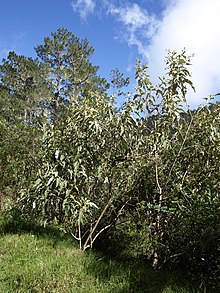Buddleja domingensis
| Buddleja domingensis | |
|---|---|

| |
| Scientific classification | |
| Kingdom: | |
| (unranked): | |
| (unranked): | |
| (unranked): | |
| Order: | |
| Family: | |
| Genus: | |
| Species: | B. domingensis
|
| Binomial name | |
| Buddleja domingensis | |
| Synonyms | |
| |
Buddleja domingensis is a species endemic to the uplands of Haiti and the Dominican Republic, growing in rocky, limestone ravines, along forest edges and roadsides; it was first described and named by Ignatz Urban in 1908.[1][2]
Description
B. domingensis is a dioecious or possibly trioecious shrub or small tree 2–6 m high, with subquadrangular, lanate young branches bearing leaves with petioles 1–2 cm long, membranaceous ovate-lanceolate to lanceolate 13–24 cm long by 3–8 cm wide, tomentose to glabrescent above, lanate below. The yellow inflorescences are 10–27 cm long, with one or rarely two orders of branches, comprising heads 1.5–2.5 cm in diameter, each with 20–50 flowers, borne in leafy-bracted racemes; the corolla tubes are 3–3.5 mm long. Ploidy: 2n = 38 (diploid).[2]
Cultivation
The species is not known to be in cultivation.
References
